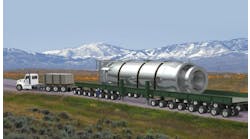Today’s smart digital valve positioners have incredible capability and flexibility as to tuning, performance and diagnostics. Here we look at how to get the most out of these positioners by tuning and by making sure the valve assembly does not hinder performance and gives the position feedback needed.
First of all, the positioner needs to know the actual position of the internal flow element (e.g., plug, ball, or disk). “High Performance” control valves often have the lowest cost and least leakage and often a straightforward compliance with the piping specification for isolation valves. The appearance of a win-win situation is the root cause of poor performance that often cannot be fixed by even the best valve positioner. The feedback measurement is often on the actuator shaft. Since “High Performance” valves tend to be rotary valves, there is backlash and consequently deadband in the linkages and connections that translate actuator movement into valve stem movement. Then due to the high sealing friction particularly near the closed position from the plug, ball or disk rubbing against the seal, there is considerable friction and a poor resolution. In many cases, the valve stem may be moving but the actual plug, ball or disk is not. This stem windup (twisting) may eventually cause the internal flow element to jump to a new position overshooting the desired position. The smart valve positioner that is measuring actuator shaft position doesn’t see what is really happening in terms of stem and internal flow element position.
So what you need is a true throttling valve and not an isolation or on-off valve posing as a control valve. A true throttling valve has a diaphragm actuator, splined shaft to stem connections, a stem that is integrally cast with the internal flow element (no stem to element connections), and no rubbing of the element against the seal once it opens. To achieve isolation you then install a cheap low leakage on-off valve in series downstream of the throttling valve. For pH control, the on-off valve should be close to the injection point to reduce reagent delivery delay upon opening.
Diaphragm actuators are now available with much higher actuation pressures enabling their use on larger valves and higher pressure drops. If you still need to go to a piston actuator, the one with the least sliding friction giving the best resolution (best sensitivity) is the best choice (given the reliability is good). Again, the position shaft connections need to be splined (keylock and pinned connections have a surprising amount of play causing backlash and shaft windup). The positioner feedback mechanism must be properly adjusted to give as accurate an indication of position as possible.
Not all smart positioners have a good sensitivity and sufficient air flow capacity. Spool type positioners and low air consumption positioners will cause long response times for small and large changes in signal, respectively. Most tests done for step changes in signal of 2% to 10% don’t reveal a problem. High performance valves will be lying to even the best positioners, making diagnostics and supposed step response capabilities invalid. For faster response on fast loops, volume boosters should not replace positioners but be used on the output of the positioner with its bypass cracked open for stability.
Given that you have a good actuator, throttling valve and positioner you are still not home free until you tune the positioner. We know from PID control, that a loop’s performance is only as good as the PID tuning. In fact the Integrated Absolute Error and Peak Error are functions of the tuning settings. A loop with great valve, process and sensor dynamics will perform as bad as a loop with poor dynamics if the controller is poorly tuned.
Positioners have traditionally been high gain proportional only controllers. If a high gain sensitive pneumatic relay is used in the positioner, position control can be quite tight since the offset from setpoint for a proportional only controller is inversely proportional to the controller gain. The offset is also of little consequence, since the effect is rather minor and short term with the process controller correcting the offset. What the process controller needs is an immediate fast total response. There are much larger nonlinearities and offsets that the process controller has to deal with. The original idea of cascade control is to make the inner loop (in this case the positioner) as fast as possible by maximizing inner controller gain, which means going to proportional or proportional plus derivative control. Integral action in the inner loop is hurtful unless we are talking about a secondary flow loop for ratio control or feedforward control. The advent of smarter positioners has led to much more complex control algorithms that include integral action. The use of integral action may make the valve step response tests look better by the final position more closely matching the signal. Not realized is that the positioner gain has to be reduced and that integral action in the positioner increases the instances of limit cycles. In fact, with the process controller in manual (positioner signal constant) a limit cycle will develop from stiction in the valve unless an integral deadband is set. Also, the increase in the number of integrators in the control system means that the process controller with integral action will develop a limit cycle from backlash since there are now two integrators. So here we have the common situation where an attempt to make appearances look better we have created a problem due to lack of a fundamental understanding. Many positioners now come with the integral action turned on as a default.
The solution is to omit integral action and use the most aggressive gain setting. For the Digital Valve Controller, this means going to travel control instead of pressure control. Overshoot of the setpoint is not a problem as long as the oscillation quickly settles out. Some overshoot helps in terms of working through deadband and resolution limits faster and increasing the size of the step seen by the positioner algorithm with its sensitivity limits. In fact, a lead/lag with lead time greater than lag time on the input signal is sometimes used to accomplish the same result. You should not get hung up on the exact change in position for a change in signal. For small signal changes, the linearity due to resolution limits is going to look bad because the resolution as a fraction of a small step is large. The really important thing is that the position changes quickly and the 86% response time is fast. Positioners with poor sensitivity and tuning may have a response time that is an order of magnitude larger than possible. What the process loop really wants is the manipulated variable to respond quickly to its demands and corrections. Also, for backlash, limit cycles can be eliminated or at least the amplitude reduced by a higher gain.
For much more on how to get good valve rangeability and a sensitive and fast response see the 5/01/2016 Control Talk Blog “Sizing up Valve Sizing Opportunities” and the Control May 2016 feature article “How to specify valves and positioners that don’t compromise control”.
Make sure this is not just talk. Put yourself into a position to get the most out of valve positioners.




